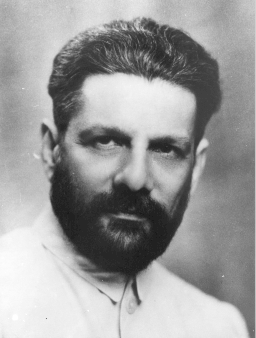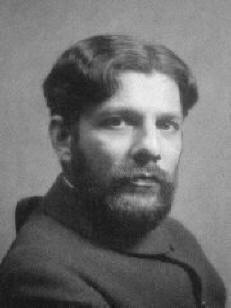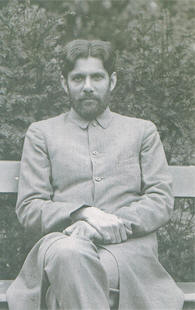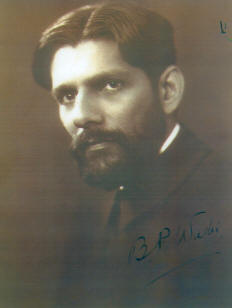
Bomanji Pestonji Wadia
(1881 - 1958)
Theosophy
Online of B.P.W.
[now a collection of 146 articles]

SHRI B. P. WADIA A BRIEF CHRONOLOGY
Mr. B. P. Wadia was born on 8 October 1881, the eldest son of Mr Pestonji Cursetji and Mrs. Mithibai Wadia. He had three sisters and one brother. Mr.Cursetji Wadia was a descendent of the famous Wadia family of shipbuilders. The Wadias came from Siganpore, a small village near Surat. Some of the sailing ships built by the Wadias are referred to even today. The Trincomalee, later renamed Foudroyant, is still preserved at Portsmouth Harbour as ”the ony surviving frigate of the old sailing navy.”
As a young student Shri Wadia studied at New High School, Bombay, conducted by J.D. Bharda and K.B. Murzban. In 1900 (on 1 January, to be exact) his father had him join his office, when be was working for a well-known British firm doing textile business. Mr. Wadia's uncle, Mr. Khursetji J.B. Wadia, was then a member of the Theosophical Society in Bombay. In 1904, Mr. B.P. Wadia joined the Bombay Branch of the Theosophical Society. He became an active member of the Branch and later in 1907 he left Bombay and went to Adyar, Madras, to stay and work there.
At Adyar Mr. Wadia was involved in a number of activities. He was assistent editor of New India. He worked in the Home Rule movernent and was interned at Ooty along with Mrs. Annie Besant and Mr. George Arundale. He started the first labour union known in Indian labour history. In 1919 be went abroad to attend a conference on the trade union movement.
He had seen for some time now a difference between his own ”back to Blavatsky” thinking and what was in actuality taking place at Adyar and he :finally severed his connection through a Statement of Resignation issued in July 1922.
From 1922 to1928 Mr. Wadia toured the United States, came into contact with the United Lodge of Theosophists, founded by Mr Robert Crosbie, and worked for it. He was concerned in the starting of U.L.T. Centres at New York, Philadelphia, and Washington, D.C. In 1925 plans were made to issue a photographic facsimile of the original edition of The Secret Doctrine. In that year plans were also made to start a U.L.T. Centre in London, U.K.
In 1922 he married Smt. Sophia Wadia, and later in 1929 he visited Europe and together with her started several U.L.T centres. They returned to India on 31 May 1929 and after staying for a period of time both in Bombay and at Ooty, started the first U.L.T. centre in India at Bombay on the 17th of November, 1929. It was then situated at 51 Esplanade Road, later renamed Mahatma Gandhi Road.
In January 1930 The Aryan Path made its appearance. ”Shravaka” wrote in the editorial in Vol 1, No 1, p. 20:
So much ”original” writing is done today, so much ”self-expression” is indulged in that, in the glamour that is raised, the chants of the Gods remain unheard. One of our tasks is to bring home the truth that it is not derogatory to respect the old age facts of the science of the soul. The study of the wise ancients convinces us that our forefathers knew better and more than we do. ...It is one of the tasks of this journal to awaken an intelligent appreciation of the hoary past so that an intelligent adaptation of some of the old truths to modern life and conditions may take place.
Shravaka is an old Theosophist who has learnt the virtue and acquired the power of saying – ”Thus Have I Heard.”
On 17 November 1930, a year after the formation of the first U.L.T. Centre at Bombay, a four-page Bulletin was issued under the title The Theosophical Movement. In it all articles were unsigned to draw attention to the contents rather than to persons. The original articles of H.P. Blavatsky and W.Q. Judge were made available by reprinting.
In 1938 a suburban centre of the U.L.T was formed at Matunga, Bombay, and in 1942, on 12 August, the Bangalore U.L.T. came into being at Maitri Bhavan.
In 1945 The Indian Institute of Culture in Bangalore was formed with Dr L.S. Doraiswamy as its first Secretary. Later the name was altered to make it The Indian Institute of World Culture. The road on which it is situated was originally called North Public Square Road, and some mail still comes to the Institute with that address.
In 1945 the William Quan Judge Cosmopolitan Home was started on a noncommunal basis, to provide wholesome food and inculcate discipline directed at encouraging habits of cleanliness, tidiness, punctuality and responsibility; and this practical expression of Universal Brotherhood was the nucleus of the Institute.
The Institute is a non-sectarian, non-govermental, private voluntary body with its chief aim to promote intercultural exchange and universal brotherhood without distinctions of any kind. It began to invite eminent persons from abroad and in India and has had persons of great eminence on its platform. Today it is a prominent landmark in Bangalore and the road on which it is situated has been re-named, after the Founder's demise, Shri B. P. Wadia Road.
In 1954, the foundation stone for the present home of the Bombay U.L.T., Theosophy Hall was laid and in the same year in November the Silver Jubilee of that centre was celebrated. In 1957 Theosophy Hall was opened for its first inaugural meeting on the 17th.of November to an overflowing audience. The Theosophical Movement had meanwhile enlarged by stages to a 40-page monthly magazine. It has been devoted to ”the Living of the Higher Life.”
On 20 August 1958 Shri B. P. Wadia passed away at Bangalore, a few days after his stirring Address entitled Our Soul's Need had been delivered at the Indian Institute of World Culture, which subsequently published it.
”Thus closed a life of selfless service. His vast insight, his courage and the breadth of his mind made him a builder of those things in life that are foundational to true living. He was an example to all of what life should be. His compassionate heart, his utter devotion to the work he had undertaken, his self-sacrifice in time, energy and money, made his life a monument of strength to those who knew him personally, and the work that he did has inspired and will continue to inspire countless human beings all over the world in their struggle through life.” (Theodore Leslie Crombie, Friend of India by E. Beswick)
Published in 1981 by:
INDIAN INSTITUTE OF WORLD CULTURE
6 Shri B P Wadia Road
Bangalore 560 004
INDIAA larger biography on B P Wadia is written by Dallas TenBroeck:
A Life of Service to Mankind____________________________________________________________________



B.P. Wadia 1881-1958
B.P.Wadia ONLINE books and articles
(first a few links in Swedish & then many more below in English )
På svenska:
Buddha och Sankara – Sålunda har jag hört av B P Wadia
Låt oss generera oss själva – Leva Livet av B P Wadia
Några observationer rörande studiet av Den Hemliga Läran
Författaren till Den Hemliga Läran (1) – Studier i Den Hemliga Läran, Första Serien
Omfattning, struktur och metod (2) – Studier i Den Hemliga Läran
Absolut och Relativ Kunskap (3) – Studier i Den Hemliga Läran
Arketypernas Värld (4) – Studier i Den Hemliga Läran
Arketypisk kunskap (5) – Studier i Den Hemliga Läran
Uppenbarelse – Sann och falsk (6) – Studier i Den Hemliga Läran
Från Inspiration till Intuition (10) – Studier i Den Hemliga Läran, Andra Serien
Det Vandrande Hjärtat – Studier i Tystnadens Röst
Ett meddelande om utträde ur TS av BP Wadia
Teosofens Väg
B P Wadia Kompendium (Nyhetsbrev nr 4)
Opublicerade brev av BP Wadia – 1
Opublicerade brev av BP Wadia – 2
Opublicerade brev av BP Wadia – 3
Opublicerade brev av BP Wadia – 4
Opublicerade brev av BP Wadia – 5
Opublicerade brev av BP Wadia – 6
Opublicerade brev av BP Wadia – 7
Opublicerade brev av BP Wadia – 8
In English:
The Search for the Master The Theosophical Movement, december 1958
The Inner Ruler The Theosophical Movement, november 1958
Will the Soul of Europe Return? offered to the first World Congress of the Theosophical Society, 1921
Svadesh and Svaraj from the T.S. Adyar Bulletin No 120, 1910.
Statement of Resignation from the Theosohical Society 1922
B.P. Wadia and the TS history (Notes written down by Dallas TenBroeck)The Building of the Home ( 8 articles of the philosophical background of the Grihastha Ashrama is presented...)
This is a link to the website: Theosophy Library Online.The Zoroastrian Philosophy and The Way of Life 4 articles on Zoroastrianism, Theosophy Magazine 1926
Our Souls Need B P Wadias last Lecture, 1958.
Mr Wadia in Buffalo 1920
Some Observations on the Study of the Secret Doctrine by Helena Blavatsky 1921.
STUDIES IN
THE SECRET DOCTRINEBook 1
From THEOSOPHY MagazineThe Writer of the Secret Doctrine Book I, First Series #1 Scope, Structure and Method Book I, First Series #2 Knowledge - Absolute and Relative Book I, First Series #3 The World of Archetypes Book I, First Series #4 Archetypal Knowledge Book I, First Series #5 Revelation - True and False Book I, First Series #6 Original Teaching, Original Impulse Book I, First Series #7 Message for Today Book I, First Series #8 A Message of HPB Book I, Second Series #9 From Inspiration to Intuition Book I, Second Series #10 Metaphysics of The Secret Doctrine Book I, Second Series #11 Altruism of the Secret Doctrine Book I, Second Series #12 Be-ness, Becoming, Being Book I, Second Series #13 Deity, Law, Being Book I, Second Series #14 The Three Hypostases Book I, Second Series #15 Growth through Self-Effort Book I, Second Series #16 The Yoga of The Secret Doctrine Book I, Second Series #17 STUDIES IN
THE SECRET DOCTRINEBook 2
From THE THEOSOPHICAL MOVEMENTBook II, Third Series #18 Book II, Third Series #19 What is Man? Book II, Third Series #20 Deity in Nature Book II, Third Series #21 The Basic Law of Brotherhood Book II, Third Series #22 The Law of Karma Book II, Third Series #23 Book II, Third Series #24 Book II, Third Series #25
Shri B.P.Wadia Chronology ( a short sketch from Indian Institute of World Culture)
B.P.Wadia – A Life of Service to Mankind (a long sketch from Dallas TenBroeck)
EXTRACTS FROM
UNPUBLISHED LETTERSLetters
From the THEOSOPHICAL MOVEMENTLetter 1
Unpublished Letters from B P Wadia – 2 Letter 2 Unpublished Letters from B P Wadia – 3 Letter 3 Unpublished Letters from B P Wadia – 4 Letter 4 Unpublished Letters from B P Wadia – 5 Letter 5 Unpublished Letters from B P Wadia – 6 Letter 6 Unpublished Letters from B P Wadia – 7 Letter 7 Unpublished Letters from B P Wadia – 8 Letter 8 Letter 9 Letter 10 Unpublished Letters from B P Wadia – 11 Letter 11 Unpublished Letters from B P Wadia – 12 Letter 12 Unpublished Letters from B P Wadia – 13 Letter 13 Letter 14 more to come
Awakening of Faith (The New York Talks - #1)Cultural Units (From World Congress of the Theosophical Society held in 1921.)
Of Measuring Rods (From The Indian Institute of World Culture)
STUDIES IN
THE VOICE OF THE SILENCEChapter
Part 1
The Slayer of the Real Part 2 The Mind of the Silence Part 3
The Virtous Mind Part 4
LIVING THE LIFE
Chapter
How to Reach Masters (1)
Defence of Theosophy How to Reach Masters (2)
The Vow of Silence How to Reach Masters (3)
The Greatest of All Wars How to Reach Masters (4)
On Getting Ready How to Reach Masters (5)
Help the Work How to Reach Masters (6)
Esoteric and Exoteric How to Reach Masters (7)
How to Reach the Masters How to Reach Masters (8)
The Path of Woe The Path of the Masters (9)
True Self-Expression The Path of the Masters (10)
The Tests The Path of the Masters (11)
The Desertion of Discipline Fight out the Field, O Neophyte! (12)
The World of Shells and Soul Fight out the Field, O Neophyte! (13)
A Man is Born Fight out the Field, O Neophyte! (14)
Divine Ethics The Divine Discipline (15)
The First Step The Divine Discipline (16)
”Blend Thy Mind and Soul” The Divine Discipline (17)
Prepare to Answer Dharma The Divine Discipline (18)
Celestial Expirience in Mundane Duties The Divine Discipline (19)
The Bonfire in the Brain The Divine Discipline (20)
"By That Sin Fell the Angels The Divine Discipline (21)
Lust for Power The Divine Discipline (22)
Anger The Divine Discipline (23)
The Way Downward The Divine Discipline (24)
Genii, Genius and Geniuses The Divine Discipline (25)
Let us generate ourselves The Divine Discipline (26)
Theosophical Reformation The Divine Discipline (27)
Loyalties The Divine Discipline (28)
Discipleship The Divine Discipline (29)
Sacrifices and Sacrifice The Divine Discipline (30)
THUS HAVE I HEARD
Chapter
Shri Krishnas Message (4)
Our Real Friends Shri Krishnas Message (5)
Buddha and Shankara Lord Buddhas Teaching (1)
Good Company – Buddhas View Lord Buddhas Teaching (6)
Lord Buddhas Teaching (7) On Getting Rich Lord Buddhas Teaching (10) Thus have I Heard Ancient Philosophy (1)
A Cock to Aesculapius Ancient Philosophy (2)
The Tathagata Light Ancient Philosophy (5) The Festival of Lights Ancient Philosophy (9) Originality and Quotation Ancient Philosophy (10) The Sin of Speech Ancient Philosophy (12) A Living Epic Ancient Philosophy (13) The Pursuit of Knowledge Ancient Philosophy (16) Vajra – The Thunderbolt Karma and Reincarnation (2) God is Law Karma and Reincarnation (3) Karma and Dharma Karma and Reincarnation (4) Human Judgment and Divine Compensation Karma and Reincarnation (5) Mans Divinity and Sophistication Karma and Reincarnation (6) Karma and Reincarnation (7) Truth and Beauty DivineDiscipline (2) Discipline and Culture DivineDiscipline (3) Self-Discipline DivineDiscipline (4) Religions and Religions DivineDiscipline (5) The Eye the Heart DivineDiscipline (6) DivineDiscipline (8) Psychology: European and Asiatic Oriental Psychology (1) Gratifications of Passions Oriental Psychology (2) Lust for Living and Repentance Oriental Psychology (3) Contentment and Resignation Oriental Psychology (4) The Gem of Gems Oriental Psychology (5) Of Repentance Oriental Psychology (6) Death of the Body Universal Etihcs (2) The Moral Order of Universe Universal Etihcs (3) Archetypal Virtue Universal Etihcs (4)
| till ULTs hemsida | till toppen |
Copyright © 1998-2014 Stiftelsen Teosofiska Kompaniet Malmö
Uppdaterad 2014-03-23